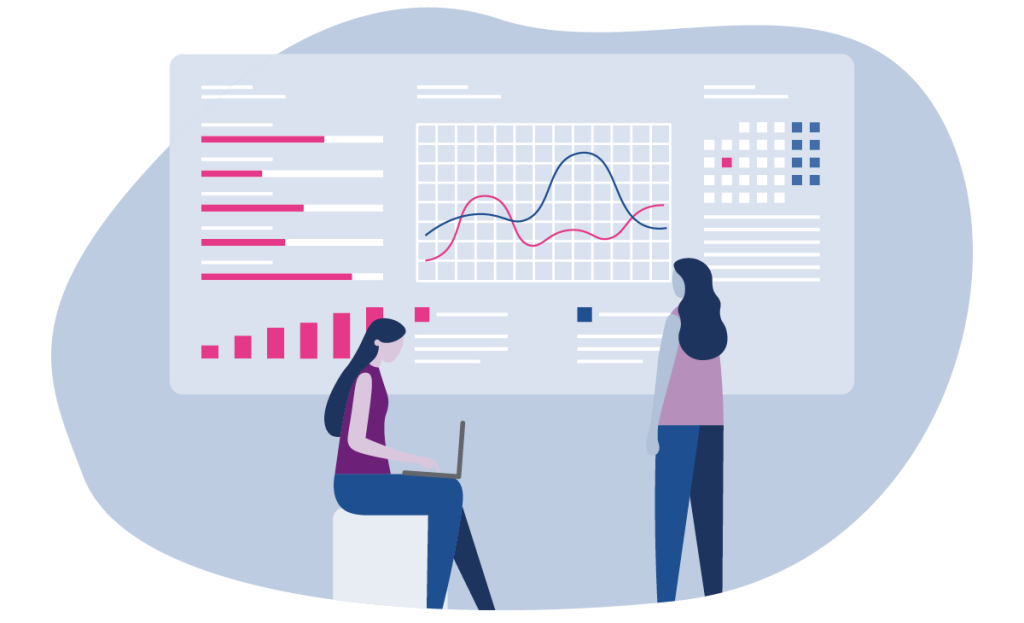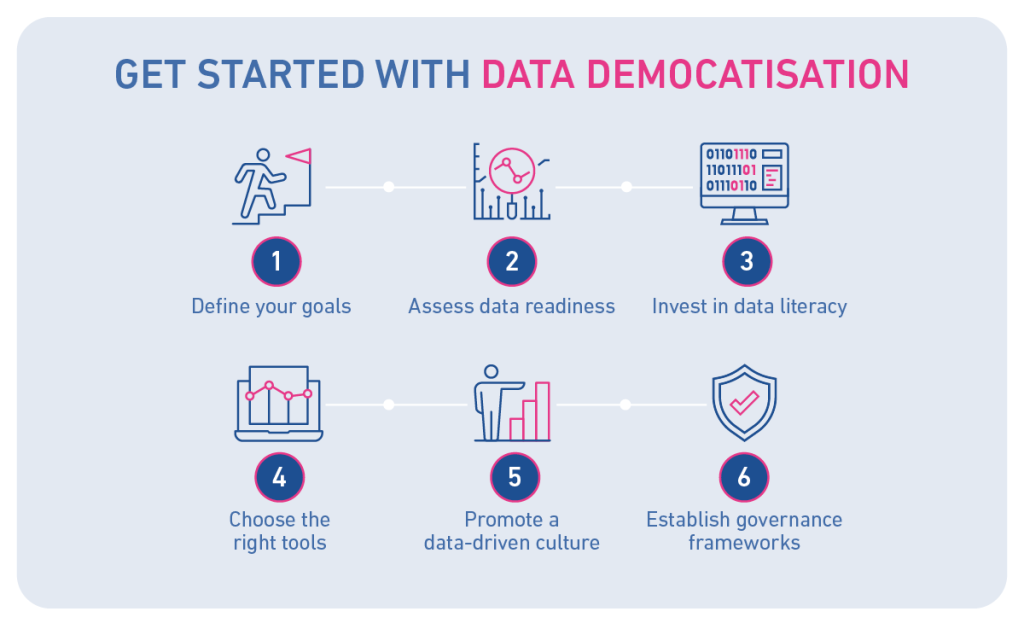What is data democratisation and why is it important?Giving the power of data to everyone within your organisation
Guide
 Information is often seen as power, but if that information is locked away, only accessible by a select few, then many in business could be left powerless.
Information is often seen as power, but if that information is locked away, only accessible by a select few, then many in business could be left powerless.
For many organisations, information and data have been in siloed systems, analysed only by specialists, and its insights have often remained untapped by the broader workforce.
This is where the concept of data democratisation comes in. Known as data democratization in the US, the idea is about breaking down these barriers and silos and putting the power of data in the hands of everyone within an organisation. There is so much transformative potential for data democratisation, with many benefits for UK businesses including gaining a competitive edge, as long as it is carefully implemented.
What is data democratisation?
Data democratisation is the ongoing process of making data readily available and usable by everyone within an organisation, regardless of their technical background. This can be through easy-to-use tools that require minimal analytics or technical understanding.
This breaks down the traditional approach of siloed information and having to rely on the skills and knowledge of data scientists and analysts for data-driven insights.
Data democratisation breaks down these barriers by:
Empowering users
It provides individuals with the tools and resources they need to access, understand and analyse data for themselves. This can include user-friendly dashboards, self-service analytics platforms and training programmes that foster data literacy.
Promoting data accessibility
Data is made discoverable and easily accessible through centralised data stores and intuitive interfaces. This allows users to find the data they need quickly and efficiently, without relying on IT teams or data specialists.
Encouraging data literacy
Data democratisation goes beyond just access. It emphasises education and skills development to ensure users can interpret data effectively, draw meaningful conclusions, make data-driven decisions and communicate their findings persuasively.
Key takeaway
Data democratisation is about unlocking data for business users of all levels so that anyone can understand and analyse data to support the work they do.
Why is data democratisation important?
The benefits of data democratisation extend far beyond simply making data accessible for an entire organisation’s workforce. Data has the potential to transform our world and enable innovation. Here’s how it empowers businesses in the UK:
Improved decision-making
When more people have access to data, decision-making becomes more objective and evidence-based. This reduces reliance on a gut feeling or isolated occurrences, compared to what data shows us to be representative, which in turn leads to more strategic decisions and hopefully more successful outcomes.
Increased agility
Data empowers organisations to identify trends and opportunities quickly. This allows them to efficiently and effectively adapt to changing market conditions and capitalise on emerging trends before competitors do, providing a competitive edge.
Enhanced collaboration
Data democratisation not only breaks down silos, but instead fosters a culture of data-driven decision-making across departments and organisations. When everyone is working with the same datasets, teams can collaborate more effectively and achieve common goals.
Improved customer experience
Understanding customers is key to business success. Organisations can leverage data to understand their customers on a deeper level. This allows them to provide a more personalised experience, with specific offerings, as well as anticipate customer needs. Ultimately, using data can deliver a more satisfying customer experience which can have a positive effect on customer retention.
Key takeaway
Data democratisation breaks down traditional data silo-d approaches by making it available and useable by all.
Data democratisation in action
Here’s a closer look at how various sectors are leveraging data accessibility to achieve strategic goals.
Retail
Data analysis and creating a single customer view helps retailers personalise customer offers and promotions, optimise in-store product placement, and manage inventory levels more effectively.
For example, data analysis allows retailers to tailor promotions and offers to individual customer preferences. In real life, this translates as supermarkets sending their customers coupons based on past purchases, or a clothing store recommending outfits based on browsing history.
From a business perspective, real-time data on sales trends and customer demands allows for more efficient inventory management. This reduces the risk of running out of stock and overstocking, leading to improved profitability and customer satisfaction.
Finance
When looking at credit risk assessments, banks and financial institutions leverage data to assess creditworthiness more accurately, enabling them to approve lending for a wider range of customers while mitigating risk. This can be particularly beneficial for small businesses seeking access to capital.
From the customer perspective, financial institutions can also utilise customer data to personalise service interactions. This means they can offer targeted financial advice for each customer and streamline potential loan applications.
Healthcare (NHS)
Data analysis plays a crucial role in improving patient care pathways. Healthcare professionals can gain insights into treatment effectiveness, identify potential complications and personalise treatment plans for better outcomes.
In addition, data can help the NHS identify areas for cost savings, such as streamlining administration or optimising resource allocation between hospitals. This allows for better utilisation of limited resources.
Transportation (TfL)
TfL utilises data to optimise public transportation routes based on passenger demand and usage patterns and reduce congestion during peak hours by promoting carpooling initiatives or alternative modes of transport.
TfL also utilises data collected from sensors and cameras to analyse traffic patterns in real time. This allows for dynamic traffic management strategies, such as adjusting signal timings or diverting routes during peak hours.
How to get started with data democratisation

Data democratisation is all about empowering everyone in your organisation to leverage data, but it requires a strategic approach. Here’s a roadmap to get you started with data democratisation:
Define your goals
The first step is to identify the specific challenges you want data democratisation to address, such as whether you are aiming to improve customer service interactions by personalising recommendations, or you want to optimise marketing campaigns by identifying high-value customer segments. Clearly defined goals will help you determine the type of data that needs to be made accessible and the tools required for effective analysis.
Assess data readiness
Before granting widespread access to data, it’s important to evaluate the current state of your data infrastructure. Consider and check whether your data is clean, accurate and organised, and whether any security or access control issues need to be addressed. Investing in data quality initiatives might be necessary to ensure the integrity and reliability of the information your employees will be working with.
Invest in data literacy
Data democratisation is not just about granting access to information; it’s about empowering everyone to leverage it effectively. After all, not everyone in your organisation will be a data scientist. Providing training programmes and resources that teach employees how to access, understand and analyse data is crucial. These programmes can cover topics like data visualisation, basic data analysis techniques and best practices for responsible data use.
Choose the right tools
Thanks to technology, complex coding is no longer a prerequisite for data analysis and there are a variety of user-friendly tools that cater to different skill levels. Consider implementing self-service analytics platforms with intuitive dashboards and drag-and-drop functionalities so they are user-friendly for everyone. Explore data visualisation tools that allow users to create compelling charts and graphs to communicate insights effectively.
Promote a data-driven culture
Data democratisation thrives in a culture where data-driven decision-making is encouraged at all levels of the organisation. It must start from the top down, with leaders setting the tone by incorporating data analysis into leadership discussions and decision-making processes. Beyond this, recognising and rewarding employees who successfully leverage data to improve their work further reinforces this data-driven approach.
Establish governance frameworks
While data accessibility is key, it’s equally important to ensure responsible data use. Develop clear data governance policies that everyone has access to and that outline data ownership, access controls and security protocols. This ensures data integrity, minimises the risk of misuse and fosters trust within the organisation.
Data democratisation is a continuous process that requires ongoing commitment, continuous improvement and fostering a culture of data exploration. By following these steps and adapting them to your specific needs, you can unlock the power of data and empower your workforce to make data-driven decisions that drive success.
How can we help?
If you’re getting started and want to establish your business’ data mindset, a data maturity assessment can help. We’ll help you review understanding and attitudes to data across your business, spot issues and recommend the next best steps you can take.
Aperture Governance Studio, our easy to deploy and outcome driven governance platform, is an ideal tool for a business pursuing a data democratisation strategy. Locate, map and understand the data across your system landscape; capture in business-terms the definitions for each data item; manage, control and implement policies for your data; assign owners to critical business data; highlight data quality issues and more – get in touch today to explore how the platform can help you.











